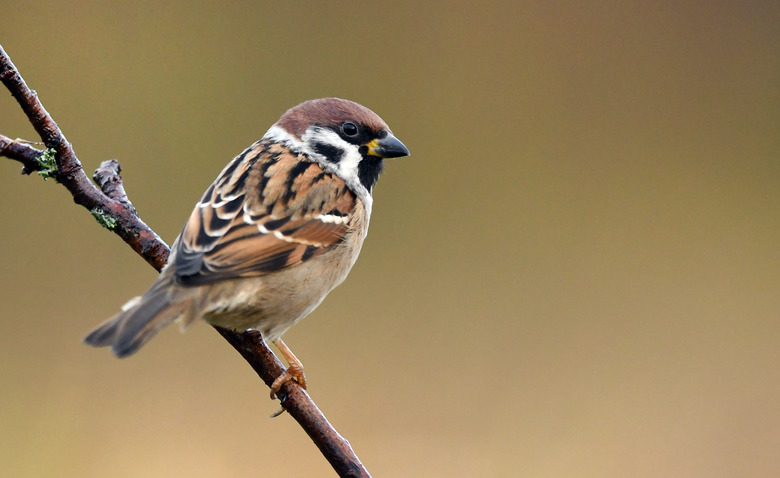Sparrow & Finch Differences
For many people, the difference between a sparrow and a finch is unclear. They are both common small birds in North America that often live in populated, urban areas. You can easily be unsure which one you are seeing on the tree branch in your backyard. There are, however, numerous differences between the two kinds of birds if you observe closely. In the past, people had a habit of calling any small, wild bird a sparrow, which has further confused the issue, because even old classification records of birds can be misleading. For those interested in becoming especially well-versed in the differences between finches and sparrows, an identification guide might prove useful (see the Resources section).
Birds That Prefer City Life
Birds That Prefer City Life
There are a great many species of both sparrows and finches, but not all of them spend time around humans. If you're seeing these small birds near agricultural areas, suburbs or cities frequently, they likely are the ones that fit into the taxonomic family Passeridae, or house sparrow, or the family Fringillidae, or house finch. Both types of birds are far more likely to live among populated areas, especially in, on or near manmade buildings. Their nests are even known to cause electrical shortages by interfering with wiring. They are so ubiquitous in parks and streets in North America that they tend to become part of the background for inhabitants, as unremarkable as grass and squirrels. Both bird families benefit by living among human society; they gain prepared shelter, protection from predators, discarded food and material for nests.
Opportunistic House Sparrows
Opportunistic House Sparrows
House sparrows do not live in rural areas that are uninhabited by people, and if they are found at all in the far north or desert areas of North America, it is only in the close presence of people. They are most commonly located in urban areas, and you can spot them in yards, noisily fluttering down from traffic light poles and storefronts on busy streets, and in country areas around farmsteads, especially livestock.
House sparrows eat a mix of wild food, including grasses and insects, and discarded foods they obtain by scavenging. They eat commercial birdseed in feeders, discarded livestock feed, and are even known to grab insects by following lawnmowers.
They are unrelated to other North American sparrows, owing to the earlier habits of naming many small birds "sparrows." Both sexes weigh approximately 1 ounce, are 5.9 to 6.7 inches long and have wingspans ranging from 7.5 to 9.8 inches. They are stocky, with full chests, rounded heads, short tails and blunted but powerful beaks. House sparrows' dominant colors are white, gray, brown and black. Females are mostly a dull grayish brown all over, with some noticeable black and brown stripes on their backs. Like many bird species, males are the more brightly colored sex; breeding male house sparrows have white cheeks, a black bib, a gray head, and vivid brown and black markings on its back.
Surprisingly Red House Finches
Surprisingly Red House Finches
Like house sparrows, house finches are also happy to dwell in areas heavily populated with people and buildings. They are also commonly found in deserts, and grasslands in the western United States. House finches' appearances vary widely across North America, although this is largely because differences of their diets. They gather in groups at bird feeders or on high tree branches while they crack their seeds to get at the meat inside. They only eat plant material, including fruits, seeds, buds and even cactus.
House finches weigh less than house sparrows, coming in at 0.6 to 0.9 ounces. Both sexes of house finches are between 5 and 5.5 inches long and have wingspans of 7.9 to 9.8 inches long. To the naked eye, they are likely to seem similar in size to house sparrows. They have flat heads and relatively long, pointy beaks, and short wings. Their tails are short, but long in comparison to their wings. There is a short notch in the tail.
Like house sparrows and many other bird species, the males are more colorful than the females. Female house finches are a dull gray-brown all over, with no distinct markings; compare this to female house sparrows, which are also dull gray-brown, but have black and brown stripes on their backs. Male house finches are distinctive – they have streaked brown backs, bellies and tails, and rosy-red faces and chests. The more carotenoids in their diets, the redder their appearance. Females prefer redder mates. When male finches fly, their bright red rumps are easily visible.
Cite This Article
MLA
E., Rebecca. "Sparrow & Finch Differences" sciencing.com, https://www.sciencing.com/sparrow-finch-differences-8552196/. 22 November 2019.
APA
E., Rebecca. (2019, November 22). Sparrow & Finch Differences. sciencing.com. Retrieved from https://www.sciencing.com/sparrow-finch-differences-8552196/
Chicago
E., Rebecca. Sparrow & Finch Differences last modified March 24, 2022. https://www.sciencing.com/sparrow-finch-differences-8552196/

